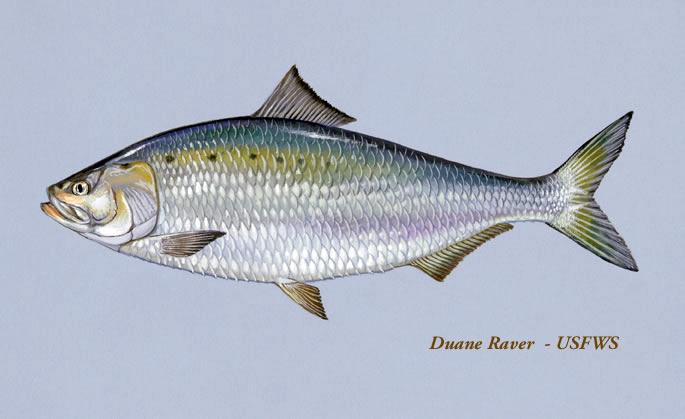Shad are classified as a Food Fish in Washington. Learn more about shad fishing below or in this June 2025 WDFW blog post.
American shad have a colorful history. Long before being imported to the Pacific side of the country, they were getting a name for themselves. As far back as the Revolutionary War they helped the cause of the future United States. After suffering through a tough winter, General Washington's undernourished troops at Valley Forge welcomed the bounty of a large shad run on the Delaware River. The volunteers filled out their diet with smoked shad.
The historic story of interest to Washington anglers, however, is when shad were introduced into the Sacramento River in 1871. The transplanted shad thrived, and soon traveled to more northerly waters. But even before shad fry were deliberately planted in the Columbia River drainage system in 1885, some of the original immigrant population strayed north from California and homed in on the Columbia River. Shad may have been caught as early as 1876, and U.S. Fish Commissioner records document that mature shad were taken from the Columbia in 1880.
Shad have also been periodically caught in Lake Washington, the Cedar River, Skagit River, Hood Canal, Grays Harbor, the Chehalis River, and other areas.
Potential impacts of shad
Shad primarily feed on plankton, and potential effects on salmon, trout, and steelhead populations are not well documented. More information on potential interactions between American shad and Pacific salmon in the Columbia River is available in this 2024 scientific paper (PDF) (PDF).
While recent shad migrations have created a productive fishery in the Lower Columbia River, the increased numbers of non-native shad and their spread into other waterways raise concerns about potential impacts (e.g., predation, competition, blocking access to fish ladders) on native fish species, including Endangered Species Act-listed salmon and steelhead.
These concerns require a cautious approach to celebrating the shad fishery, addressing the need for more research and information about their potential ecological effects.
Increased numbers of shad, alongside the decline in salmonids, signals a disruption in ecosystem health, though detailed information on the possible impacts of non-native shad in the Columbia River and other waterways is limited.
Shad in the Lake Washington watershed
WDFW began receiving numerous reports in 2024 of anglers catching American shad in the Cedar River near Renton.
In recent years shad have also been caught in the lower Sammamish River near Kenmore, and by WDFW crews while netting Lake Washington to suppress populations of non-native predatory fish such as pike and walleye. More than 1,500 shad were removed from this large King County lake in 2024.
Though shad are not classified as an aquatic invasive species, WDFW encourages anglers to retain shad caught in the Lake Washington watershed, Cedar River, or other areas where fishing is open.
Description and Range
Physical description
The back is metallic-blue to greenish, shading through white to silvery on the belly. A row or rows of dark spots decreases in size toward the tail. These spots are not always visible, but show up when the fish are scaled. A very distinctive characteristic is the saw-like serrated edge along the midline of the belly.
Like salmon and steelhead, shad are anadromous. They enter freshwater rivers in the spring to spawn. Unlike Pacific salmon, they do not necessarily die after spawning. Many shad continue to spawn annually.
In their native range, shad measure up to 30 inches in length and weigh up to 12 pounds, but usually measure up to 20 inches and weigh between 2 and 4 lbs. Females are larger than males.
Regulations
Licenses and permits
Anglers age 15 and older must have an annual freshwater, combination or Fish Washington fishing license. Licenses can be purchased online; by telephone at 1-866-246-9453; or at hundreds of license dealers across the state.
Rules and seasons
The fishing regulations for shad listed in the Statewide Freshwater Species Rules are as follows:
No min. size. No daily limit. No possession limit. Open only during open game fish or salmon seasons except Apr. 1-May 15: closed in the mainstem Columbia River downstream of Bonneville Dam.
Anglers fishing for shad must follow Statewide Freshwater Rules, including any gear or bait restrictions or closures listed in the regulations under Special Rules or in emergency fishing rules.
Where you may encounter american shad
If you want to catch shad in Washington, the place to fish is the Columbia River. And if you're fishing from shore, the only sure-fire location is below Bonneville Dam. The popular fishery at Camas Slough is mostly a boat show outside the entrance to the slough, although some shad are taken from the steamboat landing dock (in Washougal), where there is limited access.
To find good shoreline access, travel east on Highway 14 about two miles past the town of North Bonneville. Here are four specific sites to try in the Bonneville area:
- The northside shoreline below Second Powerhouse Dam: Start at the deadline and work the shoreline a few hundred yards downstream.
- Transmission towers: A good spot to try when the water is high.
- Boat ramp area: Downstream from the Hamilton Island boat ramp to the end of the access road, try any little point or eddy. Walking upstream from the boat ramp, there is about a three-block piece of shoreline with good spots all along.
- Below John Day Dam: Some shore access is available between Maryhill Park and John Day Dam. Access is primitive, however.
Lakes where this species may be found
State record
- Weight
- 3.85 lbs
- Angler
- Tom Magnuson
- Location
- Columbia River, Clark County
- Date Caught
- June 21, 2005

